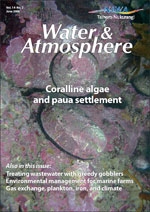PDF of this article (55 KB)

One of NIWA’s aims with this magazine is to contribute to science education in New Zealand. To this end we distribute Water & Atmosphere without charge to New Zealand high schools. Most of the magazine’s articles are assigned ‘Curriculum Connections’ to indicate which of the NZ NCEA Achievement Standards they can complement as a classroom resource. These links are assigned by Royal Society of New Zealand Teacher Fellows who are working during the year with NIWA scientists.
Remember that there is an Archive of past issues beginning with September 2000 (vol. 8, no. 3). All online articles include a pdf of the printed version and the articles are indexed via the website’s search engine.
Curriculum connections for this issue
| Article | Relevant NCEA Achievement Standards | Brief summary |
|---|---|---|
| The long and the short of it: looking after the needs of native eels | Biology 90161 (1.1), 90164 (1.4), 90457 (2.1), 90460 (2.4), 90461 (2.5), 90483 (2.9), 90713 (3.1), 90716 (3.4) | An examination of the behaviour and habitat requirements of longfins and shortfins. |
| Dining out with greedy gobblers: protozoan grazing on faecal microbes | Biology 90168 (1.8), 90464 (2.8), 90718 (3.6) Science 90188 (1.3), Level 4 US9833 | Microcosm experiments test the ability of protozoans to disinfect wastewater under low-light conditions. |
| Coralline algae and paua settlement | Biology 90161 (1.1), 90457 (2.1), 90460 (2.4), 90713 (3.1) 90716 (3.4) | Laboratory and in-situ experiments test whether coralline algae enhance the settlement and survival of paua spat. |
| Limits of acceptable change: a framework for managing marine farming | Biology 90483 (2.9) Science 90187 (1.2), 90771 (2.2) | A ‘trigger point’ framework has been devised for environmental management of New Zealand’s largest aquaculture area. |
| Connecting habitats in estuaries | Biology 90483 (2.9), 90460 (2.4) | A field experiment examines how seagrass meadows affect recolonisation. |
| Gas exchange and climate | Science 90187 (1.2), Level 1 US21612, Level 3 US6355 | One part of the SAGE experiment measured the transfer of CO2 across the air–sea interface. |
| Plankton, iron, and climate | Biology 90167 (1.7) Science Level 2 US90766, Level 3 US6355 | SAGE also tried to induce a plankton bloom in the Bounty Trough through iron fertilisation. |
| Understanding local weather and climate using Māori environmental knowledge | Geography 90204 (1.3) Māori Level 1 US6139, US19671, Level 3 US6147 Science Level 1 US18981 | Traditional indicators of weather and climate change have been compiled based on interviews with elders of two iwi. In a larger project, these have been made into a poster (see back cover). |
| The Southern Annular Mode and New Zealand climate | Science Level 1 US18981, Level 2 US6352, Level 3 US8153 | The ring of climate variability that extends from the South Pole is being linked to trends in New Zealand winds, pressure, and precipitation. |
